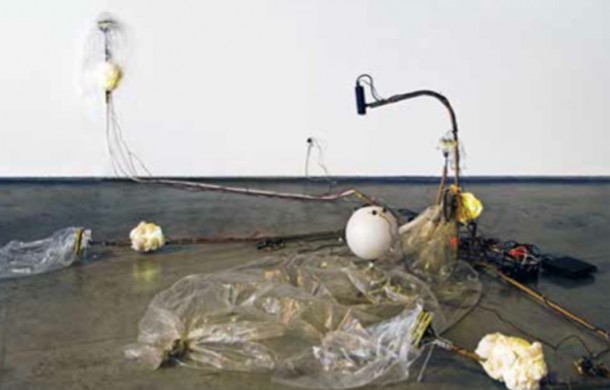PLACE OF RESIDENCE— WITH ARTISTS FROM BRAZIL AND CHINA
| May 10, 2013 | Post In LEAP 18

Video, installation, dimensions variable
German curator Alfons Hug has served as Director of the Goethe-Institut in many cities since the 1980s, including Lagos, Medellín, Brasilia, Caracas, Moscow, and currently Rio de Janeiro. Of the five BRICS countries, Hug is familiar with three. Two years ago, he began to plan BRICS-related programs, the starting point for which is an exhibition in China of works by Chinese and Brazilian artists.
Although the title “Place of Residence” is not strictly in reference to considerations of cultural, historical, or geographical differences and their impact on artistic creation, the BRICS association makes economic fortunes an unavoidable background factor. The practices of Arte Povera play a strong influence in the current economic environment, which does not lack for money; the easy accessibility of cheap materials and everyday objects also guarantees their abundance. Many of the artists participating in the exhibition opt for capturing scenes of the everyday, so as to “reflect the reality of life and to deeply engage an audience.”
In the Main Space, sound fills the room. A melody sung by Chuanju opera soprano Tian Mansha seems to make the car that Marina Rheingantz has stuck in the marsh of Atoleiro sink even deeper. Mariana Manhães’ video installation Thus (Pearl Shaped Vase) is confined inside a 12-sided polygon, a mischievous vase projected onto the ball in the center; like Pipilotti Rist, she makes strange noises, vibrating, shaking, and turning to signify her unstable existence. Tian Mansha interprets human breathing in the movement of the plastic bag that grows full then collapses as the air empties out, donning a costume of plastic film, burbling and humming in response to the pearl-shaped vase’s incomprehensible howls.
In H-Space, sound fills the room. Chimes of a ringing bell and rackety noises made by massage chairs reverberate and reflect off each other. The exhibition space is divided into two concentric squares with two side-by-side screening rooms at the center. Drawings and images line the walls of the outer square: underground graffiti and photographic fragments form Cave; Shelf by Zhang Enli seems embedded into the wall; performance art video shows outlines of alternating men’s and women’s bodies; images of landscapes by Liang Wei have no need for beginning or end; One Man’s Island by Jin Shan is a portrayal of the artist’s hysterically lonely life; Ni Jun’s canvases depict quotidian scenes— worn shirts and skirts, socks tied up in knots, fallen petals and leaves, and so on. Inside the screening rooms, Pablo Lobato’s Bronze Revirado plays in a loop. A band of young men tilt then fully reverse a large bell with a decorated yoke. The ring of the bell grows agitated as the young men quicken their push and pull. Before the next group of two run forward to try their hands, a quick gesture of prayer betrays the illicit nature of their actions. At last, one man finds himself suspended mid-air, leaving the audience likewise on edge. This booming story is at times interrupted by the noise of massage chairs from Silent Film, which is showing just one wall away, and similarly does not enjoy a moment of peace. Only the rocking water bottle and the swinging bell seem to be in rhythmic harmony. The former’s intensity and the latter’s inanity both point toward the emptiness of the everyday.
The overall design of the exhibition is no more than a parade of artworks, the intended inter-geographical and cultural communication sloppy and ineffective. Each artwork’s story is reduced to a lowest commonality, while their aesthetic is exaggerated. Whereas today’s artists are broadly engaging in a social art practice or exploring in-depth ways of viewing, this exhibition’s association of aesthetics and life is rather simplistic. Here, life has collapsed into a game, a slow-motion streetscape in black and white, a naked enjoyment, a few daily objects, a bit of distance, a daydream, a bunch of cheap colors and lights, a single breath. (Translated by JiaJing Liu)

